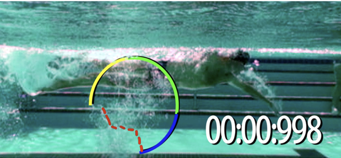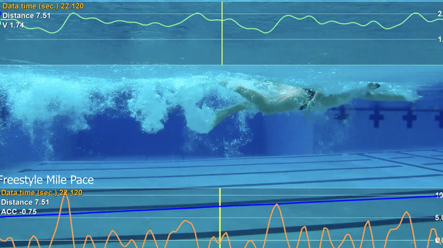Courtesy of Gary Hall Sr., 10-time World Record Holder, 3-time Olympian, 1976 Olympic Games US Flagbearer and The Race Club co-founder.
The following is an excerpt from our forthcoming book, Fundamentals of Fast Swimming.
Once the propulsion phase of the pulling arm is completed, the objective of the swimmer is to release the arm and hand from the water, bringing them over the surface for another pull. Since the hand and arm start moving forward again, reducing frontal drag through this motion becomes a primary concern, particularly while they are still underwater. On the face of the imaginary 2-foot clock, with the swimmer moving from left to right, the hand moves from the 9 o’clock position at the end of propulsion back to very near 12 o’clock, precisely where it began its underwater journey moments ago. The duration of the release phase is brief, .10 to .15 seconds, yet it is important.

Gary Sr. completes the circle with the release phase in .12 seconds, finishing right where he started the pull.

Zane Grothe is in the release phase of his right arm. He turns his little finger upward and slides the hand and arm forward, leading with the elbow, to cause as little frontal drag as possible (VM technology).
Depending on the type of arm recovery, there are two different release motions typically seen in elite freestylers. With a bent arm recovery (low octane), the elbow tends to lead the hand as it moves forward. With a straight arm recovery (high octane), the entire arm tends to leave the water as one unit and at the same time. In either release technique, once the propulsion phase is completed, the hand should turn sideways with the thumb down (or vertically) in the water to reduce frontal drag as it moves forward and leaves the water.
Not infrequently, we see swimmers try to hang on to their grip on the water too long and continue pressing upward with the hand as they release it. When this happens, from the deck, one can observe the swimmer’s hand throwing water upward and to the side behind them. While pushing hard at the end of the propulsion phase is important, particularly with hip-driven (video) and hybrid freestyle (video) techniques, it is also important to know when to let go. At that point, the hand should turn sideways with the little finger up to release it with the least amount of frontal drag as it slides forward. From the time the release phase begins to the end of the early recovery (upward trajectory), the hand and wrist should go into a relaxed position. The relaxation of the wrist and hand during these two phases of the pulling cycle, no matter how brief they are, is important in allowing the muscles of the arm and back to recover for another pulling cycle.
We often refer to the technique of relaxing the hand and wrist during the release and early recovery phases as the magic of the relaxed wrist. Every elite freestyler, even sprinters, do that. Yet we find most beginner adult swimmers or triathletes are unable to let go and relax their wrists during these two important phases. Their arms look as if rigor mortis set in on the recovery, stiff and contracted. As a result, their pulling arms fatigue more quickly. They cannot sustain the strong forces through the pulling motions for long, which demand a lot of energy.
When done properly and at race speed, not every stroke offers any true recovery time. Freestyle, butterfly and backstroke do offer some brief arm rest during the release and early recovery phases of the pulling cycle, by relaxing the hand and wrist. When offered some vacation time, take it. It will serve you well. Relax the wrist and the hand on the release phase and slide them out of the water as cleanly and quickly as possible.
Yours in swimming,
Gary Sr.
Like The Race Club on Facebook
Follow The Race Club on Instagram
Follow The Race Club on Twitter
Connect to The Race Club / Gary Hall Sr. on Linkedin
THE RACE CLUB
Because Life is Worth Swimming, our mission is to promote swimming through sport, lifelong enjoyment, and good health benefits. Our objective is for each member of and each participant in The Race Club to improve his or her swimming performances, health, and self-esteem through our educational programs, services and creativity. We strive to help each member of The Race Club overcome challenges and reach his or her individual life goals.
The Race Club provides facilities, coaching, training, technical instruction, video, fitness and health programs for swimmers of all ages and abilities. Race Club swim camps are designed and tailored to satisfy each swimmer’s needs, whether one is trying to reach the Olympic Games or simply improve one’s fitness. Our programs are suitable for beginner swimmers, pleasure swimmers, fitness swimmers, USA swimming or YMCA swimmers, or triathletes; anyone who wants to improve swimming skills. All of our Race Club members share an enjoyment of being in the water and use swimming to stimulate a more active mind and body.


